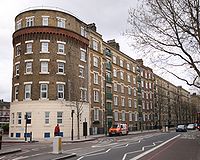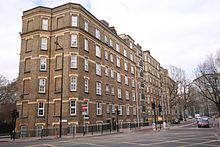- Devon Mansions
-
 Building 3 Devon Mansions - Looking west down Tooley Street
Building 3 Devon Mansions - Looking west down Tooley Street
Devon Mansions are a set of five residential mansion block buildings situated along the south side of Tooley Street in Bermondsey, London. The buildings are located within the London Borough of Southwark and are included in both the Tower Bridge and Tooley Street Conservation Areas.[1]
Contents
History
During the Victorian era, the area between Tooley Street and the River Thames to the east of what is now Tower Bridge, was one of the largest warehouse complexes in London. Completed in 1873, these warehouses housed huge quantities of tea, coffee, spices and other commodities, and became known as London’s Larder, due to the vast array of goods and provisions from across the globe.
Despite the commercial success of the warehouse businesses, there were serious problems of poverty, overcrowding and poor sanitation amongst those living in the local area. In 1875, a number of model dwelling tenement blocks were built in the area adjacent to the docks to help house local residents and address some of these social problems.[2] Originally called the Hanover Buildings, these buildings were renamed Devon Mansions during the early 20th century. The block was built by James Hartnoll[3].
Devon Mansions was an early example of social housing and, as such, its initial tenants were predominantly working class residents from the local part of Bermondsey, then known as Horsleydown. However, like many social housing initiatives close to Central London, the composition of tenants in Devon Mansions changed significantly during the 1980s following the launch of the Right to Buy Scheme under the Thatcher Government. As a result, a significant proportion of current occupants of Devon Mansions are now private owners.
Architectural Style
Devon Mansions comprises five separate, six-storey mansion blocks, all built in an identical style.
The buildings are of yellow brick, with a repetitive pattern of domestic scale sash windows organised within a simple arrangement of string courses and cornices, providing balancing vertical elements with splayed windows and stone quoins. Interest at street level comes from street railings that protect half basements and the main entrances to the buildings.
The Devon Mansion buildings are a good example the mansion block style of the era. Indeed, during its Conservation Area Appraisal, Southwark Council specifically identified Buildings 1 and 2 of Devon Mansions as “making a positive contribution” to the local area - one grade below listed status.[2]
Location
The Devon Mansion buildings are located on five separate sites spanning a distance of approximately 600 m along the south side of Tooley Street. Details of the five buildings are as follows:
- Building 1 (blocks 1-3) is located between Barnham Street and Druid Street, opposite Potters Fields and the More London complex.
- Building 2 (blocks 4-7) is located between Fair Street and Tower Bridge Road, opposite the former St Olave's Grammar School and statues commemorating Ernest Bevin, British Labour leader, and Samuel Bourne Bevington, the first Mayor of Bermondsey.
- Building 3 (blocks 8-13), otherwise known as Hartland House, is located between Tower Bridge Road and Fair Street, opposite Shad Thames. Strangely enough, Hartland House was originally a public/beer house of some description although there are no remnants of its earlier life, other than a picture in the local studies library which is testament to this fact. It is likely that the pub was converted into flats quite soon after the buildings were built as the Ordnance Survey only ever recorded it as a PH (public house) on one edition.
- Building 4 (blocks 14-19) is located between Fair Street and Tanner Street, opposite Shad Thames.
- Building 5 (blocks 20-21) is located between Tanner Street and Sweeny Crescent, opposite the southern end of St Saviour's Dock.
The nearest stations are Tower Hill (District and Circle lines), London Bridge (Jubilee, Northern and national rail), and Bermondsey (Jubilee line) each about 10–15 minutes' walk away. The walk towards London Bridge or Tower Hill is extremely scenic, particularly at night, with views of many landmarks such as the new City Hall, the Tower of London and Tower Bridge. Devon Mansions are also served by London bus routes 188, 47, N47, 381, N381, 343 and RV1.
Damage During The Blitz
 Building 3 - the site of the World War II bomb blast
Building 3 - the site of the World War II bomb blast
The area along the south bank of the Thames was heavily targeted by the Luftwaffe during World War II, due to presence of strategically important transport and storage infrastructure. As a result, buildings on Tooley Street were often at threat of destruction from German bombs during the Blitz.[4]
On 29 December 1940, in one of the most devastating bombing raids of the Blitz, German planes attacked the City of London with incendiaries and high-explosive bombs, causing what has been called The Second Great Fire of London.
During this raid a high explosive bomb landed on Building 3 of Devon Mansions, destroying a 20 metre section of the building between Blocks 12 and 13. According to the Civilian War Dead Register of the Commonwealth War Graves Commission, three residents were killed by the blast.[5][6]
The damaged section was repaired in full in 1950 - however it is still possible to see the site of the bomb impact, as the brick used to repair the building is of slightly darker colour than its surroundings. A plaque also commemorating the event is also visible at street level.
Devon Mansions Today
During the 20th century the docks that had brought so much prosperity to the area went into decline. When the London Borough of Southwark acquired Devon Mansions in 1965, it originally considered demoloshing the mansion blocks due to the squalid nature of them (most of the flats did not have any bathrooms, none of the blocks had lifts and the toilet was in with the kitchen). However, this was dismissed because of the extremely narrow site on which the blocks were built and also because of the large number of tenants occupying the blocks. A plan was therefore devised for the blocks to be modernised in stages so as to minimise disruption to the residents. Work started in 1967 and finally concluded in 1980, taking some 13 years to conclude. There were originally 525 flats within Devon Mansions but due to the installation of integral bathrooms, lifts and internal reconfiguration of the flats, this was reduced to 337 flats when the modernisation works were completed in 1980. That is why the numbers jump from 108 to 300 and something (although some of these numbers are because part of the blocks were demolished to make way for Tower Bridge in 1894. However, during the 1980s and 1990s, many of the disused but picturesque warehouses along the River Thames were converted into expensive flats, highly sought-after by those wanting to live close to the City of London.
Although apartments in Devon Mansions have not seen the same level of property price inflation as those in neighbouring Shad Thames, they have benefited from gentrification of the local area. Many of the original local authority tenants have been displaced by private owners and there is currently a healthy demand for rental properties driven by city workers attracted by the proximity to the city, and selection of top restaurants, cafes and bars in Shad Thames, London Bridge and Borough High Street.[citation needed] The freehold to Devon Mansions is owned by Southwark Council and the property is managed by the Fair Community Housing Services Tenant Management Organisation (TMO).
References
Coordinates: 51°30′04″N 0°04′32″W / 51.50098°N 0.07546°W
- ^ List of Southwark Borough Council Conservation Areas
- ^ a b Tooley Street Conservation Area Appraisal
- ^ http://www.lyons-family.co.uk/Lyons/bermondsey-history/Lyons-homes-bermondsey/Hanover%20Buildings/hanover.htm
- ^ List of V1 and V2 bomb sites and casualties in SE1
- ^ List of casualties from Dec 29, 1940
- ^ CWGC Debt of Honour Register
External links
Categories:- Housing estates in London
- Buildings and structures in Southwark
- Buildings destroyed during World War II in the United Kingdom
- 1870s architecture
- History of Southwark
Wikimedia Foundation. 2010.

